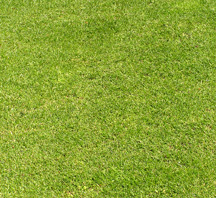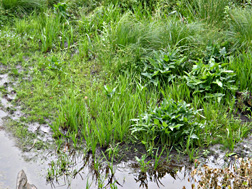Preparation for Starting a Lawn
Major Feature
In the UK as in many other countries, a lawn has been the central feature of most gardens for decades, if not centuries.
There is little doubt that a well-maintained lawn repays many times over the cost and effort for its upkeep. It is the equivalent in the garden of a carpeted floor in the house. When looked after, it is pleasing to the eye, it provides a backdrop for most other elements of garden design and it provides a safe play area for children and pets.
Design for Purpose
When laying a new lawn, first decide why you want it.
If it is for ornamental purposes, then you will need to use fine grasses that don't normally stand up well to heavy use such as children playing ball games or regular garden parties.
In fact, it has been said that you cannot have a fine lawn and children at the same time. Whether or not you agree with that statement, it is certainly wise to consider the main intended uses so that the lawn can be established with appropriate grasses.
Turf or Seed

The second decision is whether to buy turf or to grow the lawn from seed.
Turf
Turf is certainly the option of choice for quick results and you can generally create the lawn at almost any time of the year. Laying a new lawn with turf has been likened to growing the lawn in one place and then transporting it, almost like a carpet, to be laid in another location.
Seed
Growing the lawn from seed has the advantages of being the cheapest option and you generally have a wider selection of grass types from which to choose. However, the lawn takes longer to be established and you are more restricted as to the time of year.
Whichever approach you choose, however, careful preparation of the ground is essential.
Preparing the Ground for a Lawn
There are a number of tasks you need to consider when preparing for a new lawn. Some take time, others demand effort and some will cost, so it is worth thinking about them as part of the planning:
- Your battle with weeds will be much easier if you deal with them as a first priority. Any perennial weeds that are left in the ground will inevitably grow through the lawn where they will spoil the appearance and be more difficult to deal with.
Removing weeds needs to be done before using any powered means of preparing the ground such as a rotovator. Otherwise, the weeds may be buried and hidden from view, only to reveal themselves much later. You may also make the problem worse by chopping up and spreading the roots of the more pernicious weeds.
Your options are to dig out the weeds or to use a systemic weed killer such as glyphosate that attacks the vegetation without doing harm to the soil. It may need a week or two to act on the weeds and it is worth waiting a further week or two to ensure there are no surviving weeds. - Larger objects should also be removed such as builder's rubble, large stones and tree roots. These items can interfere with the grass roots and limit their access to the moisture and nutrients they need.
- If you are unfortunate enough to be working a waterlogged site, you may need to install some drainage. This problem may result from a number of causes, such as a high water table, a heavy clay based soil or excess water run off from neighbouring land. The latter problem is becoming more and more common with the increasing use of hard landscaping. (see Installing Drainage System for more information)
Drainage typically involves digging trenches in a herringbone pattern across the land and laying 3in or 4in diameter clay pipes.
The pipes need to be inclined in the direction you want the water to flow and, of course, there needs to be a suitable outlet such as a drain to receive the surplus water.
If you are not confident about doing the work correctly yourself, then you need to seek professional help since improperly laid drainage will badly affect the quality of the finished lawn. Look at some of our advertisers to see what is on offer and typical costs. - Having removed all unwanted materials, the soil itself needs to be cultivated. Lawns don't need a great depth of soil so 5in or 6in should be sufficient. For anything but the smallest lawn, this can be an arduous task if done by hand and therefore you may be well advised to hire a powered rotovator. However you need to take care with powered equipment not to go too deep since this will damage the structure of the top fertile soil, where all the life is, and the subsoil.
This may well leave you with a very uneven surface and therefore you may need to move your soil around a bit to remove high spots and fill in any dips. A series of pegs driven in at intervals combined with a long straight piece of wood and a spirit level are useful aids to getting the levels right. - The soil then needs to be compacted. It is not intended to turn it back into a solid mass, but it needs to be sufficiently compacted to ensure it is stable and to remove any air pockets. If this isn't done at an early stage, it will happen as soon as people start to use the lawn and will result in an uneven surface.
Suitable weather conditions play a role at this stage. The soil should neither be too dry nor too wet since either condition will make your work so much more difficult. You can deal with dry soil by giving it a good watering and then leaving it for a day or two. There is little you can do with excessively wet soil other than wait for it to dry out naturally.
For a smaller lawn, you may be able to compact the soil by walking on your heels back and forth across it in both directions. For a larger area, it may be better to hire a decent sized roller. Either way, the finished ground should be near enough flat with perhaps a very slight slope from the centre to the edges to help with water run-off.
Of course, if the lawn is on ground that already has a pronounced slope, then your aim will be to achieve a surface that is reasonably consistent. - Consider the finished height of the lawn in relation to any surrounding hard landscaping such as paths or patios. This may mean that you need to introduce additional soil or perhaps remove some soil. If you plan to lay turf, then you need to take the thickness of the turf into account.
If you need to obtain additional soil, be careful where it comes from since the last thing you want to do is to introduce new weeds or weed seeds. - The new lawn will need plenty of nutrients to get established and therefore it is a good idea to incorporate a slow release fertilizer into the soil at the preparation stage. The surface needs to be lightly raked over to the consistency of a new seed bed and this action will also serve to incorporate the fertilizer.

Read more about Lawns |
Read more about Plants |
